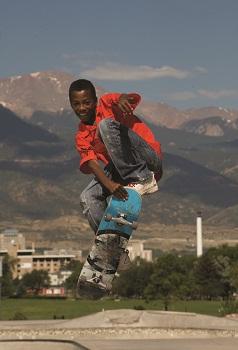
 |
| Photo courtesy of Heather Heinks |
Whether you ride a skateboard or a bike, whether you ride a plaza, a bowl or a race course, you’re one of a growing family of athletes. You’re an extreme athlete, and you’re always looking for a new place to ride. The ever-increasing interest in extreme sports, particularly skateboarding and BMX, has put a lot of pressure on communities to build facilities to accommodate the expanding numbers of athletes. Extreme sports venues represent a unique set of design, building and operations challenges, however, one that many communities don’t figure out until it’s too late.
“The demand is out there. A lot of communities just put up the smallest, cheapest skatepark possible to meet that demand, but they end up investing a bunch of money into a park that’s too small, that’s tucked off in a corner by the woods so it becomes a place to hang out and cause trouble.” This observation wisdom comes from possibly one of the country’s most experienced skatepark experts, Heidi Lemmon, executive director of the Skatepark Association of the USA (SPAUSA). “It benefits communities to build skate/BMX parks that suit their athletes’ needs, that can accommodate events and programming, and that are highly visible. It’s good for the athletes and their families. It’s good for everyone.”
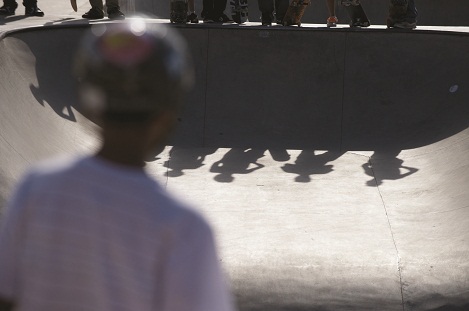 |
| Photo courtesy of Colorado Springs Convention and Visitors Bureau |
Parks for All
The bottom line is this: skateboarding and BMX are here to stay. Where ever you live, chances are, there are young athletes looking for a place to ride. What’s more, extreme sports events are growing, too. They’re getting bigger, they’re making more and more money, and they’re looking for new homes. Embrace this wave of popularity and create parks that accommodate everyone, as well as offer ideal event venues, and your community is bound to come out ahead.
Skate, BMX or Both?
Skateboarding is typically associated with parks that contain concrete bowls, vertical ramps and/or street plaza designs. Other skateboarding events, such as distance skateboarding, are gaining popularity as well, although those events don’t require a dedicated facility.
BMX racers use tracks, while freestyle BMX riders use the same, or similar, facilities as skateboarders. BMX track racing is a unique sport, independent of freestyle BMX in terms of governing bodies (USABMX governs BMX racing only) and in terms of facilities. Many cities with strong actions sports communities have both park and track facilities, and many cities with track facilities look to Evansville, Indiana’s Burdette Park BMX as their model. The host of many regional, national and even international events, Burdette Park BMX is known for its amazing course and remarkable community of riders.
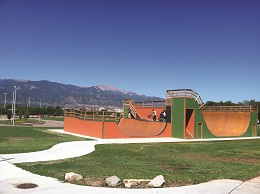 “It’s a BMX thing,” says Angie Daub, director, Burdette Park BMX. “You won’t meet a stranger in BMX. Everybody’s family at our track. We are all volunteers. We have parents who volunteer their time also and even kids who come out and help.”
“It’s a BMX thing,” says Angie Daub, director, Burdette Park BMX. “You won’t meet a stranger in BMX. Everybody’s family at our track. We are all volunteers. We have parents who volunteer their time also and even kids who come out and help.”
While BMX racers might have a family and a dedicated facility, finding a place to ride, for freestyle BMX athletes hasn’t always been so easy. Today, multi-use parks that include both skaters and BMXers are the preferred choice, promoted by athletes and experts in both sports. Years ago, however, in the early days of the skatepark boom, builders insisted that BMX riders not be allowed in skateparks.
“Lion’s Den skatepark is a skate-only facility because at the time it was built, that was the general wisdom,” says Ryan Garcia, action sports specialist, city of Fresno Parks and Recreation. “The contractors told us that we couldn’t allow BMX riders in the park because they would cause damage and void our warranty.”
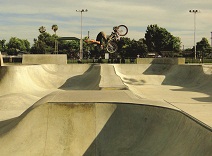 |
| Photo courtesy of Erik Engstrom |
The first concrete park in Fresno, Lion’s Den ushered in the action sports era that is now roaring in Fresno. According to the BMX Riders Organization (BRO), a nonprofit organization dedicated to providing information and assistance to those seeking public facilities for BMX riders, Fresno “might be the most BMX-friendly city in California.” So it’s no surprise that shortly after building their first skate-only park, the city turned immediately to providing a home for its BMX athletes.
“Mosqueda is our bike park, which we built in 2008,” says Garcia. “We built Lion’s Den in 2001-2002, and the BMX community didn’t have a place to go, so we got a grant and built a BMX-only park to give them a home too.”
Mosqueda is the largest BMX only concrete park in the country. Fresno enlisted its local BMXers to design the massive 30,000-suare-foot park along with Wormhoudt Inc., a design firm specializing in public skate facilities.
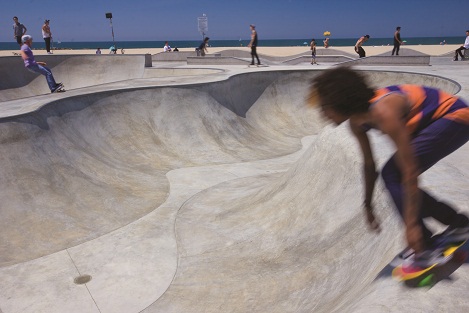 Fresno illustrates one of the key points of success, involving its community in the design phase of its BMX park. Dean Dickinson, a skatepark advocate and member of BRO, who served on the Skatepark Leadership Advisory Team (SPLAT) for Portland, Oregon, says that getting input from the athletes is crucial.
Fresno illustrates one of the key points of success, involving its community in the design phase of its BMX park. Dean Dickinson, a skatepark advocate and member of BRO, who served on the Skatepark Leadership Advisory Team (SPLAT) for Portland, Oregon, says that getting input from the athletes is crucial.
“Get good public input on what people want from the design. [Skatepark builders] are going to build what they’d prefer to skate, so you need kids showing up to the meetings, saying ‘We want bowls’ or ‘We want a plaza,’” says Dickinson.
But there are other crucial factors to the success of a new facility, says Dickinson. “Make your park multi-use. It’s a better use of funds, and multi-use parks bring everyone together, which is good for the community. Also, location is so crucial, just making sure it’s visible. A good location to me would be within an existing community park that has a community center. You want to be sure there are restrooms, drinking fountains, good parking, and not a huge, busy road nearby. You don’t want kids getting hit riding over to the park.”
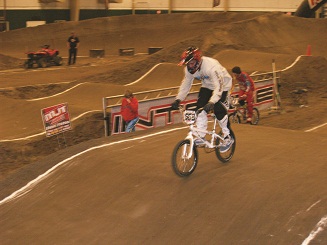 |
| Photo courtesy of Colorado Springs Conventifon and Visitors Bureau |
Making it Work
Community involvement is key to making these facilities work, and Colorado Springs offers an example of how just one citizen – no matter how young – can make an extraordinary difference.
“Our skatepark got built right about the time the community crashed. A lot of people were like, ‘What?’ But the plans were already in the works,” says Cheryl McCullough, sales manager, sports and special events, Colorado Springs Convention and Visitors Bureau. “The park, Colorado Springs Memorial Skate Park, is open to skate and BMX and turned out great. Team Pain designed it, and the kids, they love it. They take ownership of it. If there’s a dusting of snow on a Saturday morning, you’ll see those kids out there sweeping the park.”
Speaking of ownership, Colorado Springs’ own pro skater Jonathan “Jono” Schwan started a non-profit organization, Sk8-Strong, that helps skateboarding athletes achieve their goals and promote a healthy environment at skateparks. The 15-year-old not only led the effort to build vertical ramps in Colorado Springs Memorial Skate Park, but also helped bring World Cup Skateboarding to Colorado Springs for the inaugural Rocky Mountain Rampage in 2012.
Colorado Springs is also home to a well-known BMX track, Pikes Peak BMX, host of the State Games of America and the Rocky Mountain State Games.
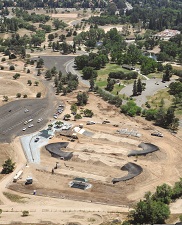 |
| Photo courtesy of City of Fresno |
Building the Best
As with Colorado Springs Memorial Skate Park’s vert ramp addition, even existing parks can be enhanced to increase the park’s interest for athletes as well as event hosting capabilities. But if you’re starting from scratch, what would make the best park for your community?
First, follow Dickinson’s advice and ask everyone. Don’t make the mistake of thinking that just because you don’t (yet) have a park in your area, you also don’t have skaters, BMXers and event organizers.
“Back when Calgary was building their first [skatepark], they were planning to start small,” says Lemmon. “Then they did an official survey to gauge the interest. More than 30,000 kids reported in that survey that they’d use the park. That was roughly three times the number registered for Little League at the time.”
Once you’ve done your homework, find a good location and a great design/builder.
“Visibility is huge. If you put a massive skatepark out on the edge of town in the woods, where no one can see it, you’re going to have problems,” says Dickinson. “Put it near a community center or a police station. And hire a great design/builder, people who are skaters and BMXers. Grindline and Dreamland are two of my favorites.”
Event organizers provide another great resource for planning parks that will bring in community-appropriate events. Christine Kovacs is the creator and director of the Central Valley AM JAM, a series of skateboard events that take place annually in California.
“When my sons were younger, we spent all our time traveling to California amateur skateboard tournaments. The closest event was at least an hour away,” says Kovacs. “One day, I thought, we have a lot of great skateboarders in the area, and great local shops, why not plan something here? I wrote a general letter to the cities around us, and three or four cities’ parks and rec departments emailed me back. We were fortunate they were so willing to work with us.”
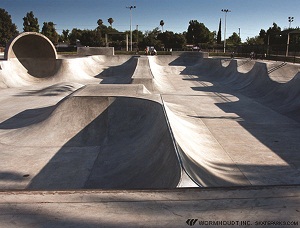 Entering its fifth year in 2013, the Central Valley AM JAM attracts around 100 skaters to each of its four events. It gives the area’s athletes a place to compete and grow as competitors, and it has created a strong community.
Entering its fifth year in 2013, the Central Valley AM JAM attracts around 100 skaters to each of its four events. It gives the area’s athletes a place to compete and grow as competitors, and it has created a strong community.
“I think cities sometimes have that mentality that’s based on all these bad stereotypes,” says Kovacs. “I’ve never had an issue at my event. I’m not saying everyone is perfect, but these kids are just jazzed to be there. Once the people from the city see our events, everything changes. Maybe some of these kids look gnarly, but once you see a skater hit an awesome trick, you go, ‘Wow, these kids are real athletes.’ It gives them a chance to be seen doing something they’re really good at.”
Once you have a great park, though, the work isn’t done. “With Portland parks and rec, we have BMX and skate camps, and they teach etiquette. Do it grassroots and show kids ownership and how to respect their communities.”
Kovacs agrees. “Cities spend a lot of money on these skateparks. Spend it smartly, and you can have events that will bring all kinds of people to your city who otherwise wouldn’t be there. They’ll stay in your hotels, eat in your restaurants and buy your gas. And your community will be stronger for it.”
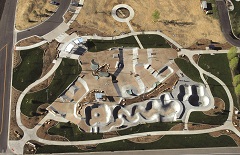 |
| Photo courtesy of Team Pain Skateparks |
Partner Up
Even if you’ve built the right park, you still need make it easy for events to come to you. Martin Ramos, owner of Jacksonville, Florida’s legendary Kona Skatepark as well as the organizer of several events, says that cities sometimes put up barriers that make it hard to host events.
“Accessibility is what we offer at Kona, and it’s crucial,” says Ramos. “Cities are often unrealistic with the amount of red tape and expenses they require, often their facilities are difficult places to do events. Almost 100 percent of city parks are not designed to maximize the skateable area. There’s no seating, no place to watch, no electric, no bathrooms, no water fountains, no parking. The things you’d do for a ballfield, cities should so for their skateparks too.”
If you Build It, They Will Shred
The point is simple: the athletes are out there. The events are out there. Just create a venue that welcomes them, and you have a surefire sports events hit on your hands. In Ocean City, Maryland, a city that already has a great skatepark facility, skating is so big that they also build a new skatepark venue every year. The action sports spectacular, the Dew Tour stops by Ocean City each year and hires a construction team to build and break down its own beachside skatepark. In 2012, thousands of people showed up to check out the action. For communities friendly to this new generation of athletes, it’s just another day in the park.

